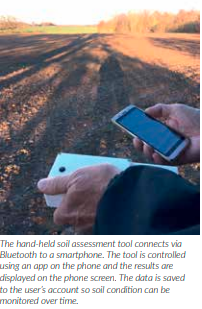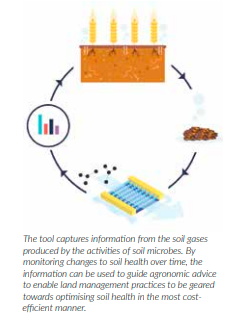The future to understanding soil health lies in a tool that can sniff the gases produced by the soil’s microbial life.
You can’t optimise what you can’t measure, and the vital activities of microbial life in the soil are currently difficult to measure outside of a specialised academic laboratory. P.E.S. Technologies is therefore using cutting edge semiconductor technology to develop a sensor that can quickly assess soil health using a simple hand-held sensor out in the field. The sensor “sniffs” the soil to detect all the various gases produced by the soil’s microbes. By using artificial intelligence the soil health analysis system can learn what the different smells mean and give greater insight, on the spot, into soil health than current tests to asses soil biology.
The journey of getting your soil into a really good condition often starts with switching to no-till practices. But beyond that there are decisions upon decisions that need to be made to regenerate soil biology from choosing the best crop types to have in your rotations to which cover crops to plant. Additionally, there are a whole host of exciting new biostimulants to try out as well as reductions in nitrogen fertiliser applications that can be explored. Further, with nematicides disappearing from the market, optimising biofumigation processes that produce gluconsinolate gases in the soil to control PCN may become a priority in future.
But each farm is unique and what works best on one farm may not work best on another. So, the first step to managing soil health should be to measure it and then monitor changes over time as they occur depending on changes to management practices. However, currently the tools available to assess soil biology have limited capabilities and there are only a few to choose from.
To make the right agronomic decisions to optimise a farm’s soil health in the most cost-effective way for each farmer, a tool is needed that makes soil health assessments easy, affordable, quick, and comprehensive. On top of all that, data is needed that doesn’t become obsolete the minute soil scientists make new discoveries that change our understanding of what a healthy, functional soil is.
While huge strides are being made in the field of DNA analysis, the samples still need to be sent off to a laboratory and the costs per test are very high. Therefore, most currently used tests for monitoring soil biology rely on gas sensing—but they only sense one gas, namely CO2. P.E.S. Technologies have instead developed a sensor that can profile all the soil’s gases with a hand-held device that can be used in the field. In other words, we “smell the soil” on the spot. This allows us to assess soil health easily, quickly, and comprehensively.

P.E.S. Technologies soil sniffer is hand-held, battery powered, and linked to a smart phone via Bluetooth. For each test, a soil sample should be taken from the top 20 cm of soil and placed into a small drawer in the device. Importantly, no other preparation of the soil sample is required. This means that each test can be completed in only 5 minutes. The agronomist or farmer never has to see the complicated smell patterns, all you get to see on the phone is the important information that is pulled out from that data: a soil health score and the various soil health indicators (for example, microbial biomass, nitrates, and pH amongst others) that are used to assess the health of the soil.

Soil gases are currently an underappreciated resource: they provide a wealth of information on soil conditions as specific microbial activities are associated with different gas patterns. As an example, microbes that are converting between the different forms of nitrates in the soil produce different gases that can then be linked to the concentration of nitrates in the soil. Additionally, bacteria and fungi give off distinct gas patterns, while different bacteria may flourish in well-aerated soils with good drainage compared with compacted soils.

Each soil test requires a single-use sensor strip, which is what detects the gases. This unique test strip was invented by Dr Jim Bailey, founder of P.E.S. Technologies and previously a semiconductor physicist at Imperial College London. Another key aspect of the sensor system is that is that the system learns and provides better results over time. It does this by analysing the raw gas data in the cloud using artificial intelligence. The same way you can train a dog to understand the meaning of more and more smells, the artificial intelligence software can be taught to do the same. The test is therefore futureproof. A simple software update can expand its capabilities and data collected in previous years can simply be reanalysed.
This is future tech, but it is not that far off being on the market! Already, P.E.S. Technologies was able to demonstrate the feasibility of sniffing soil with its sensor technology for soil health monitoring purposes by working with experts in the field in a government funded project (Innovate UK project number 133537). A further three Innovate UK funded projects (project numbers 105534, 105664, and 105668) are currently under way to help fully train the soil sniffer software and get it into the hands of agronomists and farmers by 2021/22. This soil health data will allow better land management decisions that will help improve soil health faster and more efficiently: after all, you can’t optimise what you can’t measure!
While the technology is not currently scheduled to be released until around 2021/22, suitable test sites are currently being sought and an early-release version is currently being considered. Farmers and agronomists can register their interest at pestechnologies.com/ register.
